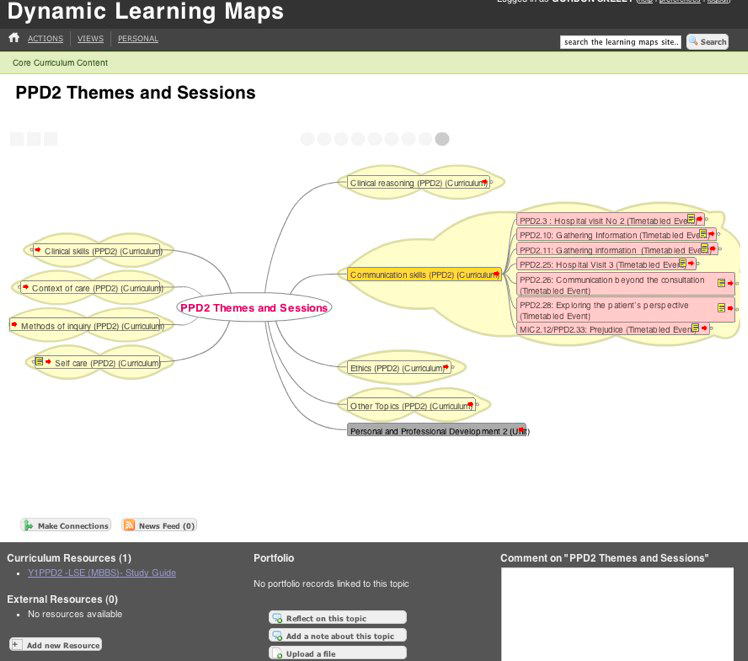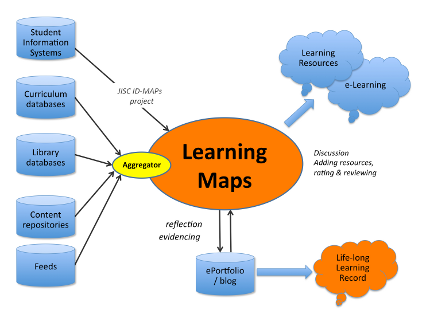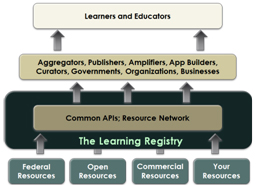One of the advantages of having being involved with JISC for a number of years (as a project and a service) is the opportunity to reflect on some activities that we’ve been involved in for some time. We thought it would be interesting to take the long view of some of our involvement with OER, XCRI and Learning Environments and reflect on what has worked and why, and where we think these activities are going next.
In this second story Lou McGill traces the history of the eXchanging Course Related Information (XCRI) specification, which is currently becoming a European and British standard (See Adam Cooper’s recent post). XCRI is a fine example of how the right people working together can develop interoperability standards that are truly fit for purpose.
A CETIS perspective of the XCRI story
Scott Wilson, Assistant Director at CETIS, describes XCRI as being ‘a community that formed to develop specifications related to course information’ (Wilson, 2010 [1]). This really captures the central aspect of the XCRI story as being about the community that came together, with the support of CETIS and JISC funding, to address a significant problem for institutions in managing their course information. Universities and colleges produce and utilise course information for several different purposes and duplication is a costly problem. The XCRI community drove forward the development of a shared vocabulary and domain map in the early days which ultimately led to the development of an internationally recognised specification. Their focus was on developing specifications to make generic aspects of a course description publicly available so they can be transferred easily between information systems. The formal outcome of this work is the XCRI-CAP (Course Advertising Profile) [2]. Lisa Corley from CETIS has written a blog post [3] which charts the development of XCRI, recognises work of these early pioneers and provides a very useful description of what it is and what benefits it offers to institutions. There is also extensive information available in the very well maintained XCRI Knowledge Base [4]. This community is still very active and now has fresh impetus from recent national HEFCE initiatives that require improved data exchange and transparency of institutional systems [5],[6] .
The XCRI and JISC CETIS timeline [7] has been developed to highlight the various activities that make up the XCRI landscape and includes JISC and CETIS activities since 2003. It also highlights some wider national and international initiatives which illustrate trends and changes in the last decade in this part of the Enterprise domain.
How we got here
The XCRI community emerged from the Enterprise SIG [8], a CETIS Special Interest Group established in 2003 that focussed on a range of standards, technologies and activities to facilitate the business processes of educational institutions. The Enterprise SIG was, essentially, a community of practice for people interested in, or involved with:
• the IMS Enterprise Specification and Enterprise Services Specification
• exchanging data about students and courses between educational systems (VLEs, Student Records, etc)
• joining up college systems to create Managed Learning Environments
• e-learning frameworks, architecture and web services
At the 2004 CETIS Conference the SIG identified a need for both a cohesive approach to standardising course descriptions and an agreed vocabulary, and in March 2005 the Enterprise SIG XCRI sub-group was formed. This group, led by Professor Mark Stubbs and Alan Paull, with the support of Scott Wilson from CETIS, became the XCRI community and have driven developments in this area in the UK since that date. In 2005 JISC funded XCRI as one of their Reference model projects [9] to define a vocabulary and appropriate (XML) technology bindings for describing course-related information. During this period XCRI produced an R1.0 schema, a repository demonstrator and surveyed 161 prospectus websites. This work happened alongside another JISC Reference Model project – COVARM (Course Validation Reference Model) [10]. Both of these reference model projects substantially mapped their respective domains and outputs fed into the eLearning Framework [11].
XCRI originally intended to ‘bridge the worlds of course marketing and course validation/quality assurance’ but, as Mark Stubbs describes [12], this became unwieldy;
“producing a course definition for validation/modification involves assembling fragments of information into a whole, whereas marketing a course involves communicating a serialized version of a subset of that assembly”
Feedback from the community, after testing the R1.0 schema in different contexts, identified a focus on a limited set of elements that supported course advertising and by 2006 XCRI-CAP was released as an XML specification. This was a very pragmatic outcome and presented something back to the community which responded to their needs and offered a usable schema for JISC to take forward with the wider HE and FE communities.
In 2007 JISC funded a range of projects [13] as part of the eLearning Capital programme around Course Management to build on the work of XCRI and COVARM reference projects. Within the course description and advertising strand a number of institutions specifically aimed to trial and refine XCRI-CAP. The resulting case studies from these projects [14] offer really valuable insight into the challenges and approaches that different types of institutions might encounter when implementing the specification and offer perspectives from a range of stakeholders such as policy makers, managers, administrators and technical staff.
JISC also funded a support project made up of members from CETIS, Manchester Metropolitan University and Kainao Ltd, who had been involved in the original XCRI sub-group. This project had a remit to further develop the specification, provide technical support to projects for the implementation of XCRI-CAP, provide a prototype online aggregation service, and promote the specification towards submission to an appropriate open standards process. The support project effectively continued the work of the XCRI reference project and proved so effective that funding was extended and continued until March 2011. Mark Power from CETIS describes [15] the various activities and achievements of this team and notes that this, and the work of the JISC funded projects, demonstrated the value of XCRI-CAP so successfully that it was placed on the strategic agenda of national agencies.
In 2008 the XCRI Support Project team engaged with other European initiatives in course information through the European Committee for Standardization (CEN) Workshop on Learning Technologies. Following this the CEN endorsed a Workshop Agreement for Metadata for Learning Opportunities (MLO) which defines a model for expressing information about learning opportunities including course information. MLO includes XCRI-CAP from the UK as well as other European specifications and is an attempt to unify these by offering a common subset, whilst still enabling local extensions and implementation architecture. This was ratified as a European Norm (EN 15982) in 2009 and was published in 2011.
Scott Wilson wrote in 2010 [16]
The formal standard defines the majority of the core concepts and information model used by XCRI. The engagement of XCRI in CEN standards development has provided an opportunity and an impetus for the XCRI community to progress to formal standardization. The current roadmap of XCRI is to develop a British Standard for its course syndication format as a conforming binding and application profile of CEN Metadata For Learning Opportunities: Advertising.
In 2009 XCRI-CAP 1.1 [17] was approved by the Information Standards Board for Education Skills and Childrens’ Services (ISB) as the UK eProspectus standard and on 1st March 2012 BS 8581 XCRI-CAP was released for public comment which would create a British Standard that is consistent with the European MLO-Advertising (EN-15982)
So far XCRI-CAP has enabled several institutions to transform practice around producing course information, especially for prospectuses, with reports of huge reductions in data duplication [18]. In 2009 the ISB estimated that a new standard for course information (XCRI-CAP) could save the sector in the region of £ 6 million per annum by removing the need to re-enter data into course handbooks and web sites.
Where we are now…
Scott Wilson from CETIS wrote a blog post in June 2011 entitled XCRI – the end of the beginning [19]. In this Scott notes a shift in the timeline of XCRI – taking us from a period of designing the specification and beta testing into ‘adoption, use and adaption’. This is a significant achievement for those involved in mapping and defining the terrain and testing out the specification across institutional systems. The community now has working exemplars which not only deliver proof of economies of scale, through reduced duplication of data, but also articulate the value of re-thinking a range of business processes affected by course information. It has long been recognised that barriers for institutions in adopting XCRI-CAP lie not in technical complexities of the schema but in the challenges around managing their data and processes to support course information, many of which involve several incompatible systems.
A range of current national drivers require educational institutions to consider how they manage and surface some of their information sets and those institutions that have engaged with XCRI-CAP are likely to find it easier to respond to some of these requirements. In early 2011 a report to HEFCE from the Online Learning Task Force [20] highlighted the challenges that students face due to insufficient, and hard to find, information about courses not dealt with by UCAS. As part of the Government Transparency agenda educational institutions are being required to provide KIS (Key Information Sets) [21] for the majority of undergraduate courses from September 2012 and to feed into the HEAR (Higher Education Achievement Report) [22] recording student achievement. Each of these initiatives provide significant impetus for institutions to consider how their course information is managed and how it links to other processes. Implementing XCRI-CAP can be a valuable way to consider this [23]. Towards the end of 2011 JISC launched a new programme called Course Data: making the most of Course Information [24]. The programme has two stages – the first which took place from September to November 2011 gave 93 institutions £10k to prepare an implementation plan to improve their course data flows and produce feeds for external agencies. 63 institutions have been selected for stage 2 to implement these plans and these began in January 2012 and will end in 2013. Outcomes and outputs of this programme are being synthesised on the XCRI Knowledge Base [25].
Where we are going…
Whilst the 2011 JISC programme will result in larger numbers of courses being advertised in XCRI-CAP format Scott argues that we need to see it taken up by major course aggregation and brokerage services. This was one of the themes discussed at the XCRI eXchange [26] in 2011 which was a National Showcase for XCRI, organised by the SAMSON [27] and MUSKET [28] projects, funded under the JISC Institutional Innovation Programme. Scott concludes his blog post with a suggestion that establishing an alliance could be the key to encourage high profile ownership and promotion of XCRI.
I think it would have to have the major aggregators on board (UCAS, Hotcourses), plus curriculum management solution providers (Unit4, Akari) and larger learning providers (e.g. the Open University, University of Manchester, MMU, Nottingham) as well as some of the smaller tools and services companies that are already working with XCRI (APS, IGSL, Smartways). It would develop the brand identity under which XCRI-CAP adoption would be recognised (not necessarily retaining anything of the original brand) and promote it beyond the reach of funded programmes into large-scale use.
Is this the future for XCRI?
I believe an Alliance like this would be a fitting development in the story of XCRI – a community driven specification having ongoing support and recognition from key stakeholders. It would be a fitting testament to the XCRI community and their achievements over the last decade.
About Lou
Lou McGill is currently working independently and has recently been involved in synthesis and evaluation activities for the HE Academy/JISC UKOER programme and the JISC Transforming Curriculum Delivery Through Technology programme. She lead the team that produced the Good Intentions report on business cases for sharing and worked on the LLiDA study (Learning Literacies in a Digital Age). She has experience of working in a range of HE institutions as a librarian, learning technologist and project manager and used to be a JISC Programme Manager on the eLearning team. In the distant past she worked for NIACE (the adult learning organisation) and in Health education for the NHS. Her interests and experience include digital literacy, information literacy, open education, distance learning, managing organisational change, and effective use of technologies to support learning. Further information on Lou’s work can be found at: http://loumcgill.co.uk






